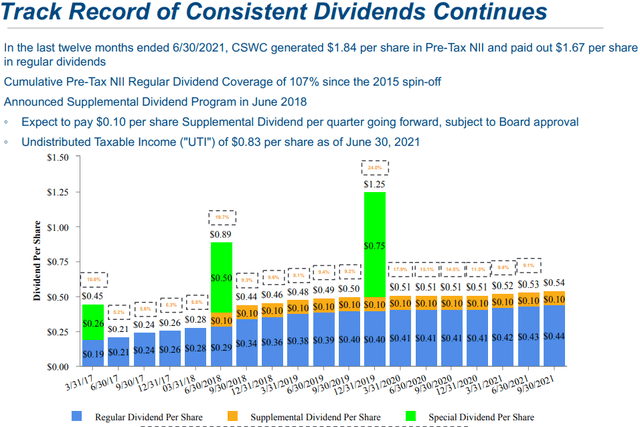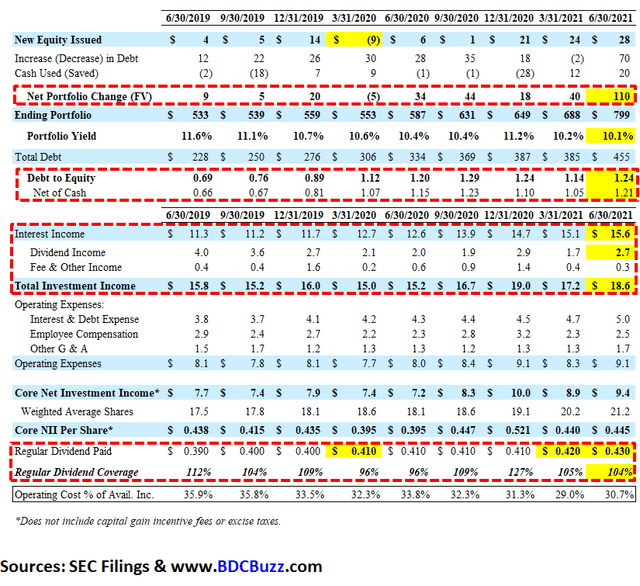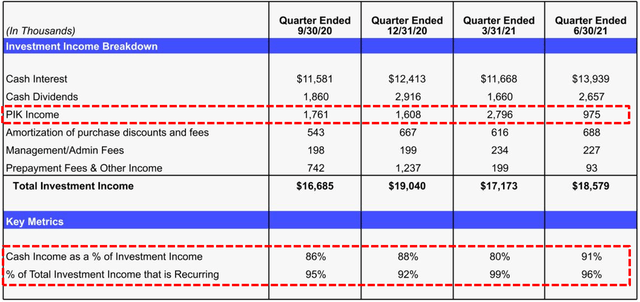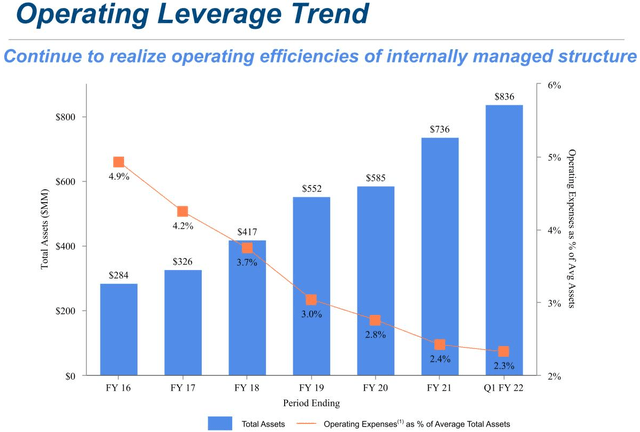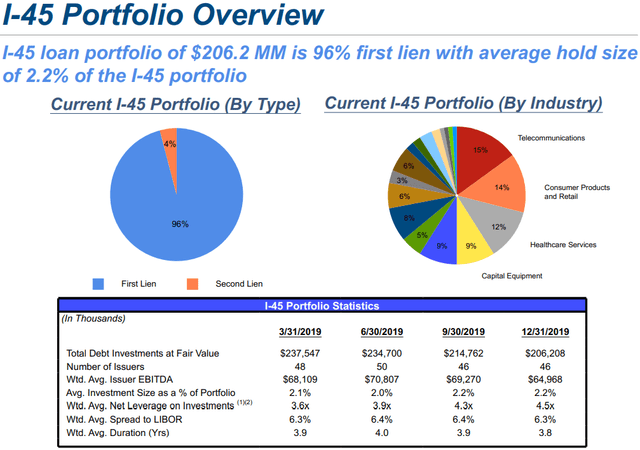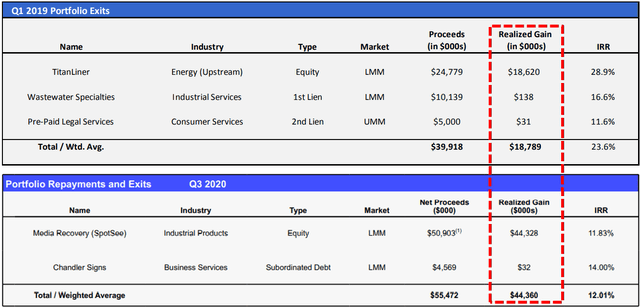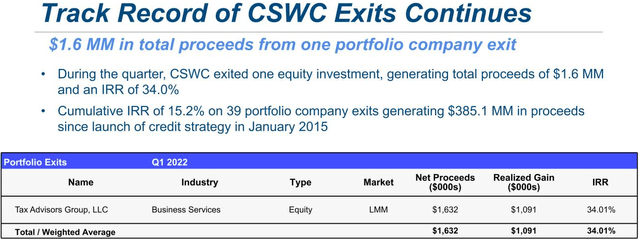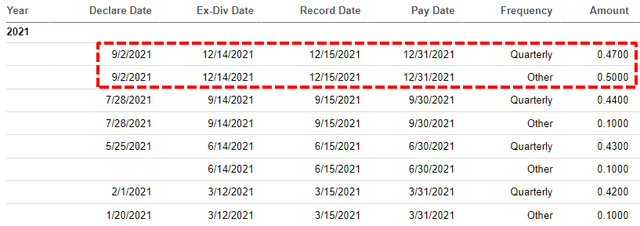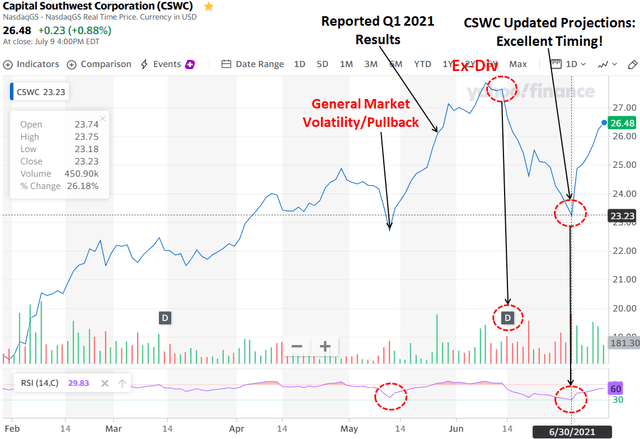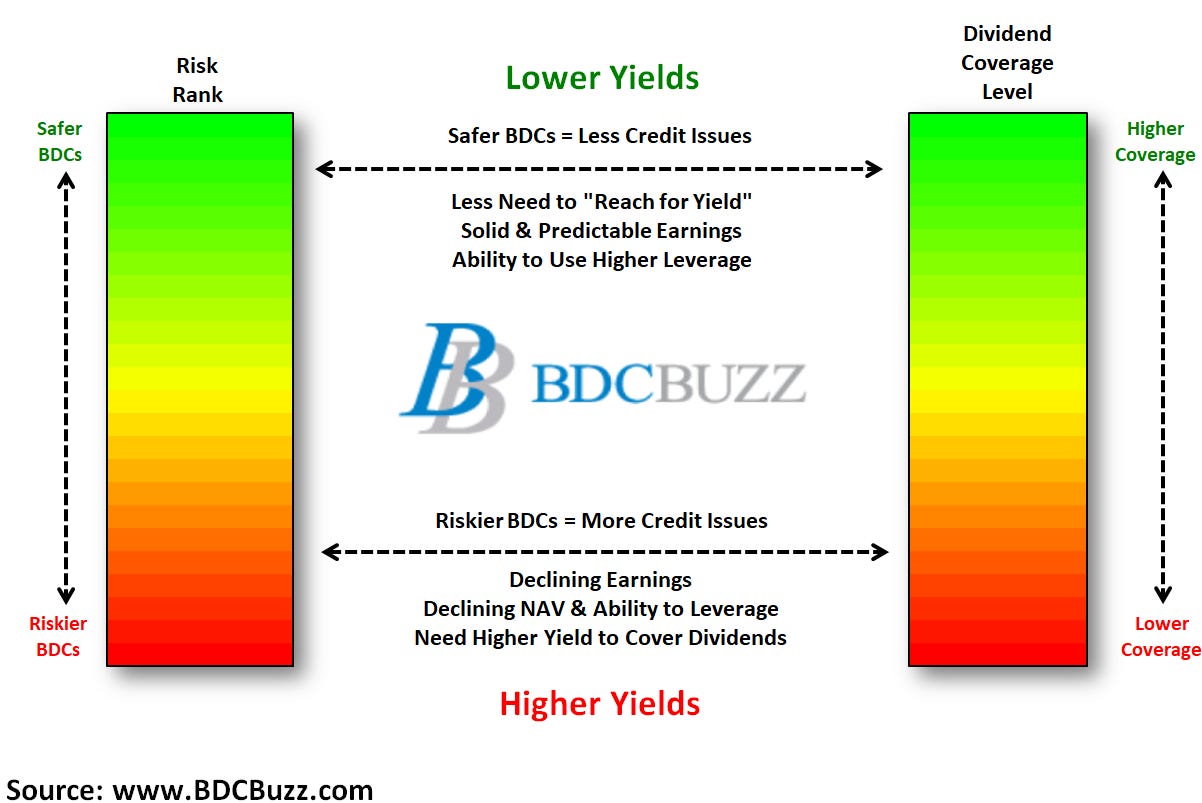
The following information was previously provided to subscribers of Premium BDC Reports along with:
- CSWC target prices/buying points
- CSWC risk profile, potential credit issues, and overall rankings
- CSWC dividend coverage projections (base, best, worst-case scenarios)
Previous CSWC Articles Follow-Up
This article is a follow-up to “Growing Dividends During A Pandemic: Capital Southwest” and “BDCs Continue To Affirm Dividends: Capital Southwest At 15%” which predicted additional increases to CSWC’s regular dividend as well as continued supplemental dividends driving higher returns to shareholders.
Source: CSWC Investor Presentation
Hopefully, readers purchased shares as the stock is up 103% since the article, and the company has increased its regular quarterly dividend four times as well as paying additional supplemental dividends including the $0.50 “final supplemental” for Q4 2021 announced earlier this month.
As you can see, CSWC has easily outperformed the S&P 500 and as discussed later I was actively purchasing shares just before the article came out.
Capital Southwest is an internally-managed BDC with an ~$800 million portfolio of mostly first-lien debt and equity positions historically providing realized gains especially in its lower middle market investments. CSWC remains a “Level 1” dividend coverage BDC implying the potential for increased regular quarterly dividends and/or additional supplemental dividends mostly due to the ability to leverage its internally managed cost structure and history of realized capital gains.
In the lower middle market, we directly originate and lead opportunities, consisting primarily of first lien senior secured loans with smaller equity co-investments made alongside our loans. We believe that this combination is powerful for a BDC as it provides strong security for the vast majority of our invested capital, while also providing NAV upside from equity investments in these growing businesses. Within our lower middle market portfolio as of the end of the quarter, we held equity ownership in approximately 57% of our portfolio companies.”
Source: CSWC Investor Call Transcript
CSWC Q2 2021 Dividend Coverage Update
For calendar Q2 2021, CSWC beat its base case projections mostly due to higher dividend income with much higher-than-expected portfolio growth partially offset by higher “Other G & A” and borrowing expenses (due to higher leverage). The company is now slightly above its lower targeted leverage (1.20) with a debt-to-equity ratio of 1.21 (net of available cash). As of June 30, 2021, CSWC had almost $17 million in unrestricted cash and almost $147 million in available borrowings under its credit facility for upcoming portfolio growth.
There was a meaningful decrease in the amount of payment-in-kind (“PIK”) income during the quarter from $2.8 million to $1.0 million due to a one-time reversal of previous cash interest income for a portfolio company recovering from “operating challenges.”
Q. “Over the last four quarters, PIK income both nominally and as a percentage of total investment income has fallen pretty materially. Is that a kind of a concentrated effort to steer away from PIK income?”
A. “I would tell you it’s actually kind of concentrated. The lower middle market company we put on non-accrual it had essentially converted from cash to PIK and then we obviously inevitably put it in non-accrual this quarter. So there was sort of a write-up of PIK for that company over the last two quarters and then it was reserved against this quarter. So therefore what you’re seeing now is actually the normal run rate of PIK.”
Source: CSWC Investor Call Transcript
Source: CSWC Investor Presentation
CSWC Continued Improvement in Earnings
CSWC’s total quarterly interest income has increased by almost 40% over the last two years to its highest level (over $15 million) driving continued dividend increases as the company leverages its internal operating cost structure.
I’m expecting additional regular quarterly dividend increases mostly due to increased returns from its I-45 Senior Loan Fund, reduced borrowing rates (discussed next), and continued portfolio growth combined with leveraging its lower cost operating structure:
Source: CSWC Investor Presentation
On August 27, 2021, CSWC closed its offering of $100 million of 3.375% unsecured notes due Oct. 1, 2026, priced at 99.418% resulting in a yield-to-maturity of 3.5%. The proceeds were used (along with $25 million additional borrowings on its lower rate credit facility) to redeem its $125 million of 5.375% notes due 2024. This will have a meaningful impact on its overall borrowing rate and I have taken into account with the updated projections.
We are pleased with our execution in raising $100 million in long-term unsecured capital. This transaction allows us to redeem the outstanding 2024 Notes, reducing our cost of debt by 2%. We expect that, on an adjusted basis reflecting the issuance of the 2026 Notes, our quarterly interest expense will be reduced by approximately $0.02 per share, which will be beneficial to shareholders in future quarters. Additionally, this capital raise and redemption pushes out our next debt maturity to 2026, providing significant capital flexibility going forward.”
Source: CSWC Investor Call Transcript
Source: CSWC Investor Presentation
In April 2021, CSWC announced that it received a license from the U.S. Small Business Administration (the “SBA”) to operate a Small Business Investment Company (“SBIC”) subsidiary. An SBIC license provides CSWC an incremental source of long-term capital by permitting it to issue up to $175 million of SBA-guaranteed debentures. These debentures have maturities of 10 years with fixed interest rates currently around 3%.
As we’ve discussed on prior calls, we have now begun operations with our SBIC subsidiary, which we’ll see going forward denoted as CSWC SBIC I. As a reminder, our initial equity commitment to the fund is $40 million and we have received an initial commitment from the SBA for $40 million of fund leverage, which is also referred to as one tier of leverage. We expect to invest this initial $80 million of capital over the next six to nine months, at which point we will apply for a second tier of leverage. Over the life of the fund, we plan to draw the full $175 million in SBIC debentures, alongside $87.5 million in capital from Capital Southwest. We are excited to be part of this program and believe it will be a natural fit with our investment strategy.”
Source: CSWC Investor Call Transcript
It should be noted that CSWC already has started utilizing its SBIC license including $7.5 million of SBA debentures through Aug. 23, 2021, as disclosed in the following SEC filing associated with the recently issued notes here.
Management is now targeting a debt-to-equity ratio between 1.20 and 1.30 including upcoming SBA borrowings.
Q. “With the receipt of the first SBIC license can you remind us whether or not you have a target leverage range both in an economic sense and on a regulatory level?”
A. “Our economic leverage is going to be somewhere in the 1.20 to 1.30 range and our regulatory leverage will be between 0.90 and 1.10. We actually think that with the pace of originations and the draws of SBIC we should be near 1 times in the next six months.”
Source: CSWC Investor Call Transcript
Management is expecting continued higher portfolio activity including prepayments (driving additional fee income) partially offset by new investments which are taken into account the updated projections:
Based on dialogue with our portfolio companies, we also believe that the active market will result in elevated prepayments for Capital Southwest over the remainder of this year. We’re looking probably at maybe somewhere in the $30 million to $60 million in potential prepayments between now and the end of the year. Now some of those have make-wholes so the newer companies that maybe have been with us a year or two, they’ll have either 102 or 101. But there’s, others that potentially come back and don’t have a make-whole. So I’m not sure that it’s (“other income”) going to be elevated beyond somewhere in the $500,000 range.”
Source: CSWC Investor Call Transcript
Also taken into account is the following guidance from management for additional dividend income and lower operating expenses (G&A) relative to the previous quarter:
Q. “Can you provide some color on the source of that dividend? And then also confirm whether that should be considered recurring or nonrecurring?”
A. “A portion of that is recurring or received from our shareholders – from our portfolio companies held in our blocker. On a quarterly basis, I think the level is around $300,000 to $350,000 is what we’re receiving. And then some of those tend to be one-time in nature from dividend income coming from portfolio companies of distributions.”
Q. “Looking at the expense side, G&A tracked a bit higher this quarter than last quarter. Is that increase driven by one-time expenses, or is that reflective of higher G&A due to increased scale of the business?”
A. “So some of this is related just to the seasonality, our annual meeting is in July. So we incurred some audit costs and 10-K. So that’s a few hundred — that’s about $200,000. And you’ll see that on — every year in the 6/30 quarter. We also noted we had $100,000 one-time costs for a headhunter for a new principle that we hired, which obviously is one-time in nature. And then, we did increase — we had one new board member and that’s increased professional expenses by $100,000. And so that will be recurring going forward.”
Source: CSWC Investor Call Transcript
Its I-45 Senior Loan Fund accounts for around 10% (previously 8%) of the total portfolio and is a joint venture with MAIN created in September 2015. The portfolio is 96% invested in first-lien assets with CSWC receiving over 75% of the profits paying a quarterly dividend of $1.6 million (previously $1.5 million) but should improve over the coming quarters due to the lower cost on its credit facility and increased leverage.
The I-45 senior loan fund showed solid performance for the quarter with asset growth and unrealized appreciation. Leverage at the I-45 fund level is now 1.4 times debt to equity. As of the end of the quarter, 96% of the I-45 portfolio was invested in first lien senior secured debt. Weighted average EBITDA and leverage across the companies in the I-45 portfolio was $77.9 million and 4.8 times respectively. The portfolio continues to have diversity among industries and an average hold size of 2.6% of the portfolio.”
Source: CSWC Investor Call Transcript
Source: CSWC Investor Presentation
CSWC Equity Positions and Realized Gains
Most dividend coverage measures for BDCs use net investment income (“NII”) which is basically a measure of earnings. However, some BDCs achieve incremental returns typically with equity investments that are sold for realized gains often used to pay supplemental/special dividends.
In the lower middle market, we directly originate and lead opportunities consisting primarily of first lien senior secured loans with smaller equity co-investments made alongside our loans. We believe that this combination is powerful for a BDC as it provides strong security for the vast majority of our invested capital, while also providing NAV upside from equity investments in many of these growing businesses. Building out a well-performing and granular portfolio of equity co-investments is important to driving growth in NAV per share, while aiding in the mitigation of any credit losses over time. As of the end of the quarter, our equity co-investment portfolio consisted of 31 equity investments, totaling $66.1 million representing 8% of our portfolio at fair value. Within our lower middle market portfolio as of the end of the quarter, we held equity ownership in approximately 57% of our portfolio companies.”
Source: CSWC Investor Call Transcript
As shown below, CSWC had realized gains of $18.6 million during calendar Q2 2018 related to the exit of TitanLiner and realized gains of $44.3 million during calendar Q4 2019 related to the exit of Media Recovery. These gains were primarily responsible for previous supplemental dividends and the “final supplemental dividend” is likely the accelerated completion of the commitment to share net realized gains with their shareholders.
Please keep in mind that CSWC has a March fiscal year-end so the quarters shown below are fiscal not calendar.
Source: CSWC Investor Presentation
I am expecting additional supplemental dividends in late 2022 as the company continues to exit equity positions:
…shareholders will continue to participate in the successful exits of our investment portfolio through special distributions as we monetize the unrealized appreciation in our portfolio.”
We continued our track record of successful exits with one this quarter. We exited our equity investment in Tax Advisors Group, generating a realized gain of $1.1 million and an IRR of 34%. To date, we have generated a cumulative weighted average IRR of 15.2% on 39 portfolio exits, representing approximately $385.1 million in proceeds.”
Source: CSWC Investor Call Transcript
Source: CSWC Investor Presentation
Summary
On Sept. 2, 2021, CSWC increased its quarterly regular dividend from $0.44 to $0.47 per share for Q4 2021 and decided to accelerate expected future payments under the supplemental dividend program declaring a “final supplemental dividend” of $0.50 per share.
Bowen Diehl, President/CEO: “We are pleased to announce today that our Board has declared a $0.47 regular dividend for the quarter ended December 31, 2021, an increase of 6.8% compared to the $0.44 regular dividend already declared for the quarter ended September 30, 2021. Our recent successful capital markets activities, combined with strong credit portfolio growth and performance, give us confidence that we can continue to steadily grow our regular dividend going forward. In addition, we believe the accelerated distribution of $0.50 per share from our undistributed taxable income (“UTI”) maximizes value for our shareholders, while still maintaining an adequate UTI balance going forward. We have significantly strengthened our balance sheet capitalization since we established the supplemental dividend program in June 2018, and thus feel confident in our ability to accelerate the supplemental dividend payment at this time. Going forward, shareholders will continue to participate in the successful exits of our investment portfolio through special distributions as we monetize the unrealized appreciation in our portfolio.”
Source: CSWC Press Release
It’s interesting to note that this announcement was 10 weeks early as the company typically announces Q4 dividends during the third week of October and large Q4 supplementals in November (after assessing taxes) as they did in 2019 for the $0.75. This means that the company is doing well and we can expect Q3 2021 to be very strong likely with a large amount of realized earnings from equity investments.
Source: Seeking Alpha
As mentioned earlier, I am expecting additional increases in the regular dividend plus continued supplemental/special dividends mostly due to:
- Leveraging its internal operating cost structure
- Continued portfolio growth
- Increased returns from its I-45 Senior Loan Fund
- Reduced borrowing rates
- Additional realized gains from harvesting equity positions
A large part of my Sustainable Dividends service is not only knowing which BDCs to buy but also knowing when to buy. For example, the “CSWC Updated Projections: Excellent Timing!” recommended purchasing CSWC on June 30, 2021, after it had fallen from $27.50 to $23.23 with an RSI of 32.20 as shown below.
Source: Yahoo Finance
What Can I Expect Each Week With a Paid Subscription?
Each week we provide a balance between easy to digest general information to make timely trading decisions supported by the detail in the Deep Dive Projection reports (for each BDC) for subscribers that are building larger BDC portfolios.
- Monday Morning Update – Before the markets open each Monday morning we provide quick updates for the sector including significant events for each BDC along with upcoming earnings, reporting, and ex-dividend dates. Also, we provide a list of the best-priced opportunities along with oversold/overbought conditions, and what to look for in the coming week.
- Deep Dive Projection Reports – Detailed reports on at least two BDCs each week prioritized by focusing on ‘buying opportunities’ as well as potential issues such as changes in portfolio credit quality and/or dividend coverage (usually related). This should help subscribers put together a shopping list ready for the next general market pullback.
- Friday Comparison or Baby Bond Reports – A series of updates comparing expense/return ratios, leverage, Baby Bonds, portfolio mix, with discussions of impacts to dividend coverage and risk.
This information was previously made available to subscribers of Premium BDC Reports. BDCs trade within a wide range of multiples driving higher and lower yields mostly related to portfolio credit quality and dividend coverage potential (not necessarily historical coverage). This means investors need to do their due diligence before buying.

